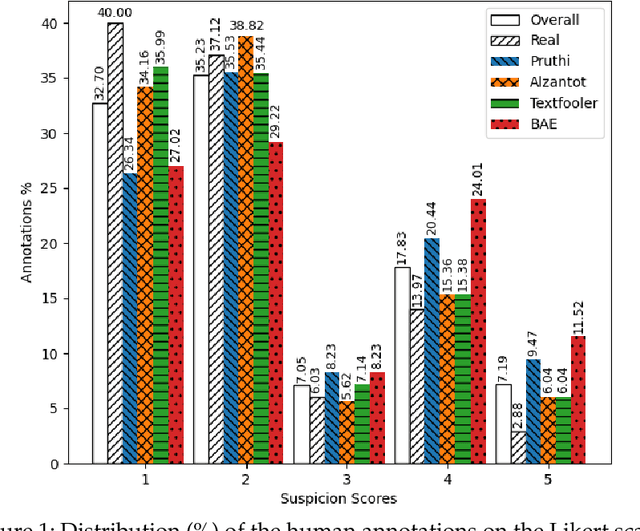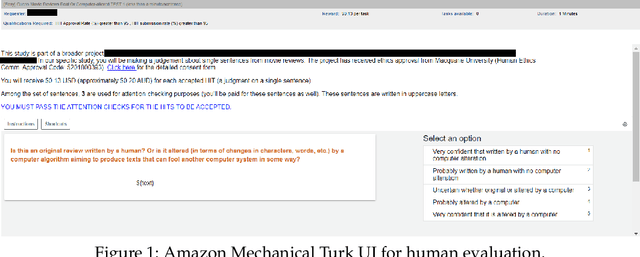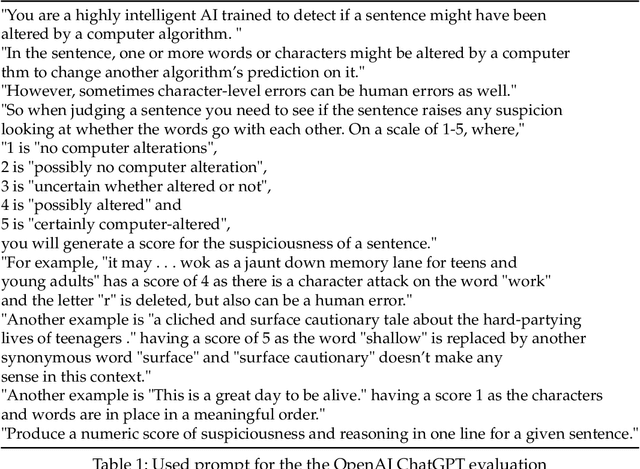Mark Dras
Microsoft Research Institute, Macquarie University
Seeing the Threat: Vulnerabilities in Vision-Language Models to Adversarial Attack
May 28, 2025Abstract:Large Vision-Language Models (LVLMs) have shown remarkable capabilities across a wide range of multimodal tasks. However, their integration of visual inputs introduces expanded attack surfaces, thereby exposing them to novel security vulnerabilities. In this work, we conduct a systematic representational analysis to uncover why conventional adversarial attacks can circumvent the safety mechanisms embedded in LVLMs. We further propose a novel two stage evaluation framework for adversarial attacks on LVLMs. The first stage differentiates among instruction non compliance, outright refusal, and successful adversarial exploitation. The second stage quantifies the degree to which the model's output fulfills the harmful intent of the adversarial prompt, while categorizing refusal behavior into direct refusals, soft refusals, and partial refusals that remain inadvertently helpful. Finally, we introduce a normative schema that defines idealized model behavior when confronted with harmful prompts, offering a principled target for safety alignment in multimodal systems.
A Survey on Progress in LLM Alignment from the Perspective of Reward Design
May 05, 2025Abstract:The alignment of large language models (LLMs) with human values and intentions represents a core challenge in current AI research, where reward mechanism design has become a critical factor in shaping model behavior. This study conducts a comprehensive investigation of reward mechanisms in LLM alignment through a systematic theoretical framework, categorizing their development into three key phases: (1) feedback (diagnosis), (2) reward design (prescription), and (3) optimization (treatment). Through a four-dimensional analysis encompassing construction basis, format, expression, and granularity, this research establishes a systematic classification framework that reveals evolutionary trends in reward modeling. The field of LLM alignment faces several persistent challenges, while recent advances in reward design are driving significant paradigm shifts. Notable developments include the transition from reinforcement learning-based frameworks to novel optimization paradigms, as well as enhanced capabilities to address complex alignment scenarios involving multimodal integration and concurrent task coordination. Finally, this survey outlines promising future research directions for LLM alignment through innovative reward design strategies.
Bi-directional Model Cascading with Proxy Confidence
Apr 27, 2025Abstract:Model Cascading, recently applied successfully to LLMs, is a simple but powerful technique that improves the efficiency of inference by selectively applying models of varying sizes. Models are used in sequence from smallest to largest, only deferring samples to large, costly models when smaller models are not sufficiently confident. Existing approaches to deferral use only limited small model confidence estimates because of the inaccessibility of the large model, although large model confidence is known to be important. We therefore propose a bi-directional approach to deferral that considers the confidence of small and large models in the cascade simultaneously through the use of a proxy for the large model. This requires a richer representation of model confidence to enable comparative calibration: we use an analysis of hidden states to improve post-invocation confidence of the small model, which in itself improves cascading results over prior approaches. We then combine this with a tiny proxy model to estimate pre-invocation confidence of the large model. We examine the proposed cascading system over challenging, multiple-choice datasets, finding improvements over standard cascading baselines reflected in reductions in deferrals to more costly models.
Myanmar XNLI: Building a Dataset and Exploring Low-resource Approaches to Natural Language Inference with Myanmar
Apr 13, 2025Abstract:Despite dramatic recent progress in NLP, it is still a major challenge to apply Large Language Models (LLM) to low-resource languages. This is made visible in benchmarks such as Cross-Lingual Natural Language Inference (XNLI), a key task that demonstrates cross-lingual capabilities of NLP systems across a set of 15 languages. In this paper, we extend the XNLI task for one additional low-resource language, Myanmar, as a proxy challenge for broader low-resource languages, and make three core contributions. First, we build a dataset called Myanmar XNLI (myXNLI) using community crowd-sourced methods, as an extension to the existing XNLI corpus. This involves a two-stage process of community-based construction followed by expert verification; through an analysis, we demonstrate and quantify the value of the expert verification stage in the context of community-based construction for low-resource languages. We make the myXNLI dataset available to the community for future research. Second, we carry out evaluations of recent multilingual language models on the myXNLI benchmark, as well as explore data-augmentation methods to improve model performance. Our data-augmentation methods improve model accuracy by up to 2 percentage points for Myanmar, while uplifting other languages at the same time. Third, we investigate how well these data-augmentation methods generalise to other low-resource languages in the XNLI dataset.
Defending Deep Neural Networks against Backdoor Attacks via Module Switching
Apr 08, 2025Abstract:The exponential increase in the parameters of Deep Neural Networks (DNNs) has significantly raised the cost of independent training, particularly for resource-constrained entities. As a result, there is a growing reliance on open-source models. However, the opacity of training processes exacerbates security risks, making these models more vulnerable to malicious threats, such as backdoor attacks, while simultaneously complicating defense mechanisms. Merging homogeneous models has gained attention as a cost-effective post-training defense. However, we notice that existing strategies, such as weight averaging, only partially mitigate the influence of poisoned parameters and remain ineffective in disrupting the pervasive spurious correlations embedded across model parameters. We propose a novel module-switching strategy to break such spurious correlations within the model's propagation path. By leveraging evolutionary algorithms to optimize fusion strategies, we validate our approach against backdoor attacks targeting text and vision domains. Our method achieves effective backdoor mitigation even when incorporating a couple of compromised models, e.g., reducing the average attack success rate (ASR) to 22% compared to 31.9% with the best-performing baseline on SST-2.
Empirical Calibration and Metric Differential Privacy in Language Models
Mar 18, 2025Abstract:NLP models trained with differential privacy (DP) usually adopt the DP-SGD framework, and privacy guarantees are often reported in terms of the privacy budget $\epsilon$. However, $\epsilon$ does not have any intrinsic meaning, and it is generally not possible to compare across variants of the framework. Work in image processing has therefore explored how to empirically calibrate noise across frameworks using Membership Inference Attacks (MIAs). However, this kind of calibration has not been established for NLP. In this paper, we show that MIAs offer little help in calibrating privacy, whereas reconstruction attacks are more useful. As a use case, we define a novel kind of directional privacy based on the von Mises-Fisher (VMF) distribution, a metric DP mechanism that perturbs angular distance rather than adding (isotropic) Gaussian noise, and apply this to NLP architectures. We show that, even though formal guarantees are incomparable, empirical privacy calibration reveals that each mechanism has different areas of strength with respect to utility-privacy trade-offs.
VaxGuard: A Multi-Generator, Multi-Type, and Multi-Role Dataset for Detecting LLM-Generated Vaccine Misinformation
Mar 12, 2025Abstract:Recent advancements in Large Language Models (LLMs) have significantly improved text generation capabilities. However, they also present challenges, particularly in generating vaccine-related misinformation, which poses risks to public health. Despite research on human-authored misinformation, a notable gap remains in understanding how LLMs contribute to vaccine misinformation and how best to detect it. Existing benchmarks often overlook vaccine-specific misinformation and the diverse roles of misinformation spreaders. This paper introduces VaxGuard, a novel dataset designed to address these challenges. VaxGuard includes vaccine-related misinformation generated by multiple LLMs and provides a comprehensive framework for detecting misinformation across various roles. Our findings show that GPT-3.5 and GPT-4o consistently outperform other LLMs in detecting misinformation, especially when dealing with subtle or emotionally charged narratives. On the other hand, PHI3 and Mistral show lower performance, struggling with precision and recall in fear-driven contexts. Additionally, detection performance tends to decline as input text length increases, indicating the need for improved methods to handle larger content. These results highlight the importance of role-specific detection strategies and suggest that VaxGuard can serve as a key resource for improving the detection of LLM-generated vaccine misinformation.
VITAL: A New Dataset for Benchmarking Pluralistic Alignment in Healthcare
Feb 19, 2025Abstract:Alignment techniques have become central to ensuring that Large Language Models (LLMs) generate outputs consistent with human values. However, existing alignment paradigms often model an averaged or monolithic preference, failing to account for the diversity of perspectives across cultures, demographics, and communities. This limitation is particularly critical in health-related scenarios, where plurality is essential due to the influence of culture, religion, personal values, and conflicting opinions. Despite progress in pluralistic alignment, no prior work has focused on health, likely due to the unavailability of publicly available datasets. To address this gap, we introduce VITAL, a new benchmark dataset comprising 13.1K value-laden situations and 5.4K multiple-choice questions focused on health, designed to assess and benchmark pluralistic alignment methodologies. Through extensive evaluation of eight LLMs of varying sizes, we demonstrate that existing pluralistic alignment techniques fall short in effectively accommodating diverse healthcare beliefs, underscoring the need for tailored AI alignment in specific domains. This work highlights the limitations of current approaches and lays the groundwork for developing health-specific alignment solutions.
Comparing privacy notions for protection against reconstruction attacks in machine learning
Feb 06, 2025Abstract:Within the machine learning community, reconstruction attacks are a principal concern and have been identified even in federated learning (FL), which was designed with privacy preservation in mind. In response to these threats, the privacy community recommends the use of differential privacy (DP) in the stochastic gradient descent algorithm, termed DP-SGD. However, the proliferation of variants of DP in recent years\textemdash such as metric privacy\textemdash has made it challenging to conduct a fair comparison between different mechanisms due to the different meanings of the privacy parameters $\epsilon$ and $\delta$ across different variants. Thus, interpreting the practical implications of $\epsilon$ and $\delta$ in the FL context and amongst variants of DP remains ambiguous. In this paper, we lay a foundational framework for comparing mechanisms with differing notions of privacy guarantees, namely $(\epsilon,\delta)$-DP and metric privacy. We provide two foundational means of comparison: firstly, via the well-established $(\epsilon,\delta)$-DP guarantees, made possible through the R\'enyi differential privacy framework; and secondly, via Bayes' capacity, which we identify as an appropriate measure for reconstruction threats.
Suspiciousness of Adversarial Texts to Human
Oct 06, 2024



Abstract:Adversarial examples pose a significant challenge to deep neural networks (DNNs) across both image and text domains, with the intent to degrade model performance through meticulously altered inputs. Adversarial texts, however, are distinct from adversarial images due to their requirement for semantic similarity and the discrete nature of the textual contents. This study delves into the concept of human suspiciousness, a quality distinct from the traditional focus on imperceptibility found in image-based adversarial examples. Unlike images, where adversarial changes are meant to be indistinguishable to the human eye, textual adversarial content must often remain undetected or non-suspicious to human readers, even when the text's purpose is to deceive NLP systems or bypass filters. In this research, we expand the study of human suspiciousness by analyzing how individuals perceive adversarial texts. We gather and publish a novel dataset of Likert-scale human evaluations on the suspiciousness of adversarial sentences, crafted by four widely used adversarial attack methods and assess their correlation with the human ability to detect machine-generated alterations. Additionally, we develop a regression-based model to quantify suspiciousness and establish a baseline for future research in reducing the suspiciousness in adversarial text generation. We also demonstrate how the regressor-generated suspicious scores can be incorporated into adversarial generation methods to produce texts that are less likely to be perceived as computer-generated. We make our human suspiciousness annotated data and our code available.
 Add to Chrome
Add to Chrome Add to Firefox
Add to Firefox Add to Edge
Add to Edge